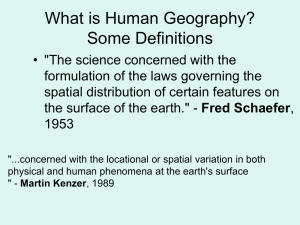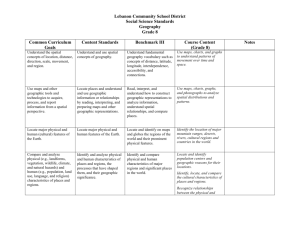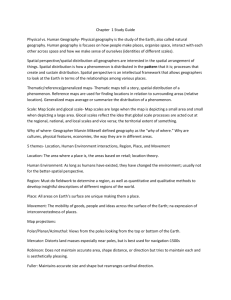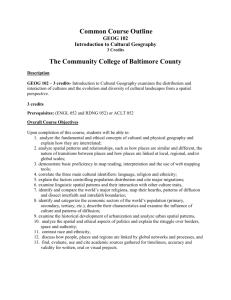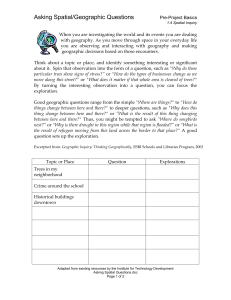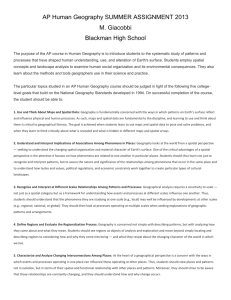National Geographic
advertisement
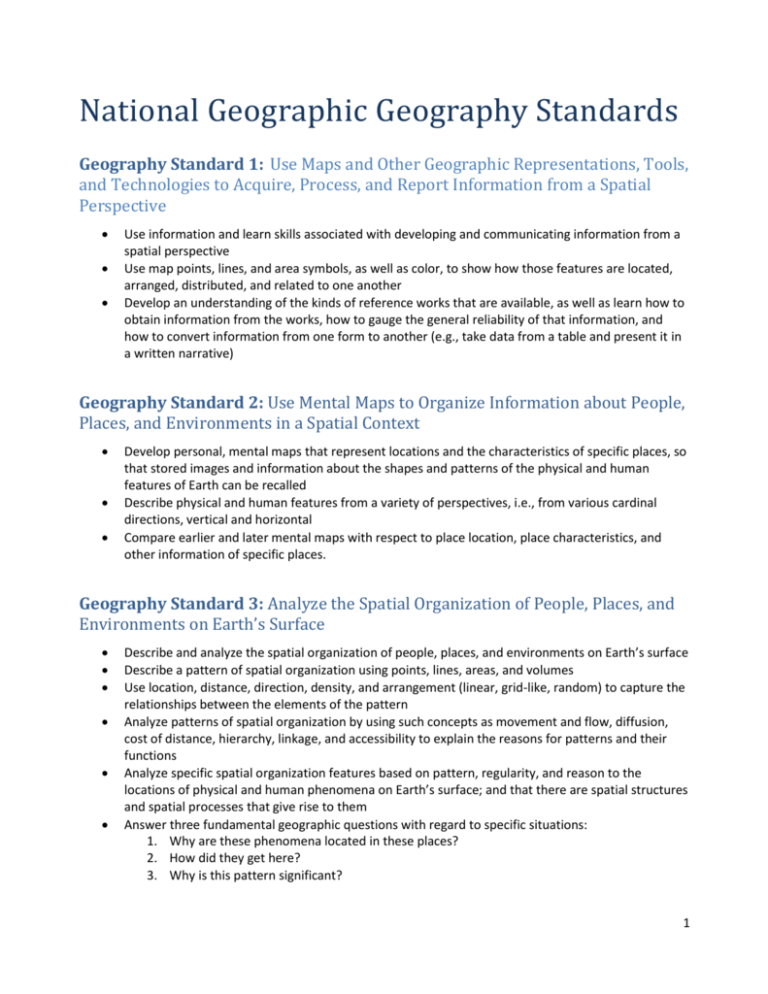
National Geographic Geography Standards Geography Standard 1: Use Maps and Other Geographic Representations, Tools, and Technologies to Acquire, Process, and Report Information from a Spatial Perspective Use information and learn skills associated with developing and communicating information from a spatial perspective Use map points, lines, and area symbols, as well as color, to show how those features are located, arranged, distributed, and related to one another Develop an understanding of the kinds of reference works that are available, as well as learn how to obtain information from the works, how to gauge the general reliability of that information, and how to convert information from one form to another (e.g., take data from a table and present it in a written narrative) Geography Standard 2: Use Mental Maps to Organize Information about People, Places, and Environments in a Spatial Context Develop personal, mental maps that represent locations and the characteristics of specific places, so that stored images and information about the shapes and patterns of the physical and human features of Earth can be recalled Describe physical and human features from a variety of perspectives, i.e., from various cardinal directions, vertical and horizontal Compare earlier and later mental maps with respect to place location, place characteristics, and other information of specific places. Geography Standard 3: Analyze the Spatial Organization of People, Places, and Environments on Earth’s Surface Describe and analyze the spatial organization of people, places, and environments on Earth’s surface Describe a pattern of spatial organization using points, lines, areas, and volumes Use location, distance, direction, density, and arrangement (linear, grid-like, random) to capture the relationships between the elements of the pattern Analyze patterns of spatial organization by using such concepts as movement and flow, diffusion, cost of distance, hierarchy, linkage, and accessibility to explain the reasons for patterns and their functions Analyze specific spatial organization features based on pattern, regularity, and reason to the locations of physical and human phenomena on Earth’s surface; and that there are spatial structures and spatial processes that give rise to them Answer three fundamental geographic questions with regard to specific situations: 1. Why are these phenomena located in these places? 2. How did they get here? 3. Why is this pattern significant? 1 Geography Standard 4: Describe the Physical and Human Characteristics of Places People’s lives are grounded in particular places. We come from a place, we live in a place, and we preserve and exhibit fierce pride over places. Our sense of self is intimately entwined with that of place. Who we are is often inseparable from where we are. Places are human creations and the geographically informed person must understand the genesis, evolution, and meaning of places. Compare the physical and human characteristics of 100 yards in every direction from your home with another 100 yard radius of any other location in the same greater community. Include the physical aspects of climate, landforms, soils, hydrology, vegetation, and animal life; and the cultural aspects of language, religion, political systems, economic systems, population distribution, and quality of life. Compare the physical and human characteristics of 100 yards in every direction from your home with another 100 yard radius of a closely similar neighborhood in Buenos Aires, Argentina. Include the physical aspects of climate, landforms, soils, hydrology, vegetation, and animal life; and the cultural aspects of language, religion, political systems, economic systems, population distribution, and quality of life. Describe how these selected places have changed over time – how have ideologies, values, resources, and technologies changed? What place-altering decisions have people made about the use of land, how to organize society, and ways in which to relate (such as economically or politically) to nearby and distant places? Knowing how and why places change enables people to understand the need for knowledgeable and collaborative decision-making about where to locate schools, factories, and other things and how to make wise use of features of the physical environment such as soil, air, water, and vegetation. Knowing the physical and human characteristics of their own places influences how people think about who they are, because their identity is inextricably bound up with their place in life and the world. Personal identity, community identity, and national identity are rooted in place and attachment to place. Knowing about other places influences how people understand other peoples, cultures, and regions of the world. Geography Standard 5: People Create Regions to Interpret Earth’s Complexity A region has certain characteristics that give it a measure of cohesiveness and distinctiveness that set it apart from other regions. As worlds within worlds, regions can be used to simplify the whole by organizing Earth’s surface on the basis of the presence or absence of selected physical and human characteristics. As a result, regions are human constructs whose boundaries and characteristics are derived from sets of specific criteria. They can vary in scale from local to global; overlap or be mutually exclusive; exhaustively partition the entire world or capture only selected portions of it. They can nest within one another, forming a multilevel mosaic. Geographers define regions in three basic ways: 1. The first type is the formal region. It is characterized by a common human property, such as the presence of people who share a particular language, religion, nationality, political identity or culture, or by a common physical property, such as the presence of a particular type of climate, landform, or vegetation. 2. The second type of region is the functional region. It is organized around a node or focal point with the surrounding areas linked to that node by transportation systems, communication systems, or other economic association involving such activities as manufacturing and retail trading. 2 3. The third type of region is the perceptual region. It is a construct that reflects human feelings and attitudes about areas and is therefore defined by people’s shared subjective images of those areas. Describe formal, functional, and perceptual regions for specific locations, i.e., SCCC, Buenos Aires. Geography Standard 6: How Culture and Experience Influence People’s Perceptions of Places and Regions People’s perception of places and regions is not uniform. Rather, their view of a particular place or region is their interpretation of its location, extent, characteristics, and significance as influenced by their own culture and experience. Individuals have singular life histories and experiences, which are reflected in their having singular mental maps of the world that may change from day to day and from experience to experience. As a consequence, individuals endow places and regions with rich, diverse, and varying meanings. In explaining their beliefs and actions, individuals routinely refer to age, sex, class, language, ethnicity, race, and religion as part of their cultural identity, although some of their actions may be at least partly a result of sharing values with others. These shared beliefs and values reflect the fact that individuals live in social or cultural groups or sets of groups. The values of these groups are usually complex and cover such subjects as ideology, religion, politics, social structure, and economic structure. They influence how the people in a particular group perceive both themselves and other groups. 3


